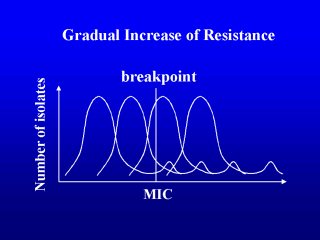 |
Surveillance work has generally
let us know whether a particular compound is still good for curing disease. The answer is
yes as long as a very high percentage of the isolates are considered susceptible. The data
can also be used to warn us of upcoming resistance, but the system is not very good for
that. There are two reasons. First, when one uses susceptibility breakpoints to determine
whether a strain is resistant or susceptible, a strain can have many resistance mutations
and still be considered susceptible. If those mutations accelerate the development of
resistance, the surveillance work will give you a false sense of security. Second, the
primary data for surveillance is generally derived only from the dominant members of the
infecting population. This is because clinical labs generally only look at well-isolated
colonies. Consequently, the growth of mutant subpopulations will not be observed. The
slide shows what is called creeping resistance. With time the curve shifts to higher
concentrations. The result is that resistance is thought to appear suddenly when it
actually develops gradually. |
